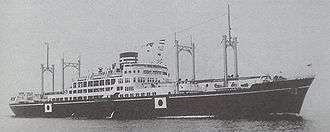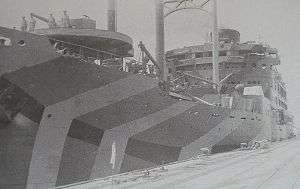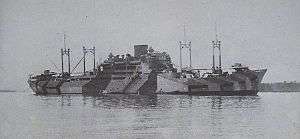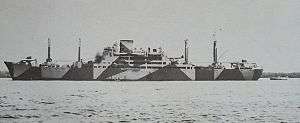Hōkoku Maru-class ocean liner
The Hōkoku Maru-class ocean liner (報國丸型貨客船,, Hōkoku Maru-gata Kakyakusen) was a class of ocean liners of Japan, serving during 1940 and World War II.
 O.S.K. Lines Hōkoku Maru in 1940 | |
| Class overview | |
|---|---|
| Name: | Hōkoku Maru class ocean liner |
| Builders: | |
| Operators: | |
| Built: | 1938 – 1942 |
| In commission: | 1940 – 1944 |
| Planned: | 3 |
| Completed: | 3 |
| Lost: | 3 |
| General characteristics [1] | |
| Type: | Ocean liner |
| Displacement: | 7,410 long tons (7,529 t) gross |
| Length: | 160.8 m (527 ft 7 in) overall |
| Beam: | 20.1 m (65 ft 11 in) |
| Draught: | 12.5 m (41 ft 0 in) |
| Propulsion: |
|
| Speed: | |
| Capacity: |
|
| Crew: | 150 |
| Armament: |
|
| Aircraft carried: |
|
Background
- 17 May 1937, the Ōsaka Mercantile Steamship Co.Ltd. (大阪商船,, Ōsaka Shōsen Kaisha, O.S.K. Lines) placed an order for three ocean liners to reinforce the Japan-Africa route. They were named Hōkoku Maru, Aikoku Maru and Kōkoku Maru (later renamed Gokoku Maru).
- They were beautiful, and luxuriously equipped[2] Their suites were named after ancient Japanese cities:[3]
Civilian service
- Hōkoku Maru was completed on 15 June 1940. Her maiden voyage was 2–12 July 1940, Yokohama-Dalian.
- On 17 July 1940, she departed to South America on her only overseas voyage. After this she stayed close to the Japanese mainland, as the Japanese Navy (IJN) feared losing her.
- Aikoku Maru was completed on 31 August 1941.
- In September 1941, both ships were enlisted by the IJN.
| Name | Builder | Laid down | Launched | Completed | Note |
| Hōkoku Maru (報國丸) | Tama Shipyards | 18 August 1938 | 5 July 1939 | 15 June 1940 | She was enlisted by the navy on 20 September 1941. |
| Aikoku Maru (愛國丸) | Tama Shipyards | 28 December 1938 | 25 April 1940 | 31 August 1941 | She was enlisted by the navy on 1 September 1941. |
| Gokoku Maru (護國丸) ex-Kōkoku Maru (興國丸) |
Mitsui, Tamano Shipyard | 31 July 1939 as Kōkoku Maru | 2 April 1942 as Gokoku Maru | (4 August 1942) | Renamed Gokoku Maru in early 1942. She was enlisted by the navy on 27 July 1942. |
Service in World War II
- Hōkoku Maru and Aikoku Maru became auxiliary cruisers, and they were assigned to the 24th Raider Division, Combined Fleet. When they learned of the outbreak of war they were north of Tuamotus.
- 27 April 1942, Aikoku Maru supported submarine I-30 which departed to Germany.
- 4 August 1942, Gokoku Maru was completed. She acted in the Indian Ocean until 30 November 1942.
- 11 November 1942, Hōkoku Maru was sunk by HMIS Bengal and tanker Ondina in the Indian Ocean. Aikoku Maru returned to Singapore.
- January 1943, Aikoku Maru and Gokoku Maru were dispatched to New Guinea They engaged in troop transportation duties afterward.
- 1 October 1943, they were classified to Auxiliary transport, and removed some armaments.
- 17 February 1944, Aikoku Maru was sunk by air raid at Chuuk.
- 10 November 1944, Gokoku Maru was sunk by a US submarine.
| Name | Career | Fate |
| Hōkoku Maru | Classified to auxiliary cruiser on 20 September 1941 | Sunk by HMIS Bengal and armed tanker Ondina at southwest of Cocos 20°00′S 93°00′E on 11 November 1942. |
| Aikoku Maru | Classified to auxiliary cruiser on 5 September 1941 Classified to auxiliary transport on 1 October 1943 |
Sunk during the Operation Hailstone on 17 February 1944. |
| Gokoku Maru | Classified to auxiliary cruiser on 4 August 1942 Classified to auxiliary transport on 1 October 1943 |
Sunk by USS Barb off Gotō Islands 33°31′N 129°19′E on 10 November 1944 |
Photos
 O.S.K. Lines Hōkoku Maru
O.S.K. Lines Hōkoku Maru O.S.K. Lines Aikoku Maru in 1941
O.S.K. Lines Aikoku Maru in 1941 O.S.K. Lines Gokoku Maru on 2 April 1942
O.S.K. Lines Gokoku Maru on 2 April 1942
 IJN Hōkoku Maru in May 1942 at Penang
IJN Hōkoku Maru in May 1942 at Penang IJN Hōkoku Maru on 29 July 1942 at Seletar
IJN Hōkoku Maru on 29 July 1942 at Seletar IJN Hōkoku Maru on 18 September 1942 at Seletar
IJN Hōkoku Maru on 18 September 1942 at Seletar IJN Aikoku Maru on 22 August 1942 at Seletar
IJN Aikoku Maru on 22 August 1942 at Seletar
Footnotes
Bibliography
- Hannig, Marcus (2012). "Japanese WW II Armed Merchant Cruisers". Warship International. XLIX (1): 34–36. ISSN 0043-0374.
- Tashirō Iwashige, The visual guide of Japanese wartime merchant marine, "Dainippon Kaiga". Archived from the original on December 7, 2002. (Japan), May 2009
- Hisashi Noma (private publication), The Story of Mitsui and O.S.K. Liners lost during the Pacific War, May 2002
- Monthly Ships of the World No.535, "Kaijinsha"., (Japan), February 1998
- The Maru Special, Japanese Naval Vessels No.53, "Japanese support vessels", "Ushio Shobō". (Japan), July 1981
gollark: There were some political things a while ago (not sure exactly when) with people wanting Northern Ireland to not be run by Britain or something?
gollark: Stupid harmful things have totally stuck around for ages. Their age makes them *harder* to displace, even. Look at smoking.
gollark: At my school they just put "Halo" and such on the network drives.
gollark: Well then.
gollark: Does it actually support Linux yet?
This article is issued from Wikipedia. The text is licensed under Creative Commons - Attribution - Sharealike. Additional terms may apply for the media files.